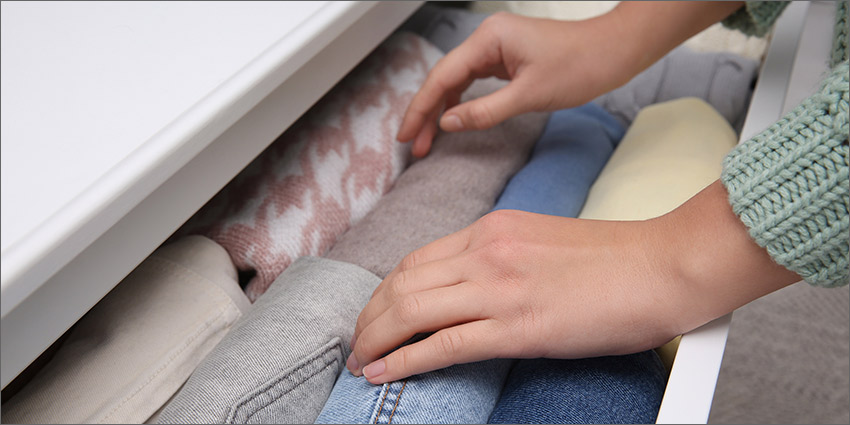You can squeeze a lot more clothes into a small space if you fold them, it’s true. Just be sure to declutter them first. Otherwise you’ll just be reorganizing clutter.

We have a laundry chute in our home.
Not really. We just fling dirty clothes over the bannisters and then next time we go downstairs, we pick them all up and put them in the laundry baskets in our utility room. The trick is to do this before unexpected guests arrive who’ll think we live like slobs (we don’t, except for these few brief minutes of abandonment each day).
We’ve done this in every home we’ve lived in since moving to the UK in 2010. Why? Because we can! It’s fun. It’s deliciously freeing. And it also reminds us of when we lived in Bali and had a wonderful housekeeper called Padmi who took care of all our laundry for us. Fresh sheets twice a week, impeccably ironed clothes, delightfully rolled panties that were a treat to unfurl.
Oh, and the best bit was when we went travelling and she helped to pack our suitcases. Most Balinese people can’t afford closets to hang their clothes, so they are masters of folding. She would fold our clothes into our bags in such a way that the creases never showed. We’d arrive at the other end, take them out of our cases, hang them up, and they’d be ready to wear. Her parting gift, when I left Bali after 20 years, was to teach me these skills, and I got quite good at it, but not as good as her.
The art of folding
People from other Asian cultures are good at folding too, especially in Japan, the home of origami and very small homes with hardly any storage space. But most westerners were not brought up this way and find it much easier to hang clothes than to fold them.
One client I worked with purchased a three-drawer dresser because she’d read a book about tidying and thought she should learn how to fold. And there the new furniture sat, unused and blocking her dressing area, while clothes piled up around it. She bought it with the best of intentions, but it added to her problems rather than resolving them.
Folding clothes and organizing them vertically in drawers (see the photo at the top of this article) does allow you to cram much more into whatever space you have available. But gradually, as you take things out and wear them, the remaining items tend to fall over. Women seem to tolerate this, whereas men feel it’s ridiculous and prefer to go back to good old-fashioned stacking clothes in piles.
My best advice is to use drawers for things that don’t wrinkle, such as socks, scarves, nightwear, underwear, tracksuit pants, and so on. Use hangers for anything that creases. And if you still don’t have enough space for all the clothes you own, you’ll either need to declutter or invest in more storage space.
Do bear in mind, though, that most people wear only 20% of their wardrobe. Figure out the 80% that’s just taking up space, let some of it go, and you’ll probably have plenty of room for the rest.
Copyright © Clear Space Living Ltd 2015, updated 2023
Resources
Online clutter clearing courses
Related articles
What your laundry pile says about your life
How to declutter your clothes with confidence
Like to read more articles like this?
Subscribe to my newsletters to receive news, articles and information about upcoming online courses by email. And I promise you – no junk mail ever.




“Folding clothes and organising them vertically in drawers … as you take things out and wear them, the remaining items tend to fall over.”
I can visualise this, but in the photo referred to, items seem to be rolled and stored horizontally? (Trying to remember Kondo: roll & store vertically?). For vertical storage, drawer-dividers forming compartments – as shown in the photo – would presumably reduce the problem of items falling over.
I learnt to roll clothes rather than fold them, as Girl Guide in the 1950s for going camping with a rucksack. Rolled clothes were much easier to pack than folded clothes – and tended to emerge with fewer creases when unrolled.
I have signed up for three of your courses. Last time I did one, several years ago, it worked wonders. Since then I was forced a couple of years ago to empty a hoarded house, under pressure, into my flat – and have been buried alive, with no energy to tackle the overload.
The items pictured in this article are quite bulky, so they may look rolled but they are in fact folded. They illustrate what is meant by vertical storage, meaning the items are folded and then stood on end in a drawer instead of being piled on top of one another on a shelf. The technique is also known as file folding because picking out the clothes you want to wear then becomes like thumbing through files stored in handing drawers in a filing cabinet to find the file you want.
Rolling clothes when packing for travelling is a great way to reduce creases while in transit. However, it doesn’t work so well for everyday use at home because the rolls tend to be stacked on top of one another so it can be difficult to find what you’re looking for.
I hope this helps to clarify this for you.
I loved this article! The bit about flinging laundry over the banisters in particular got me going. It would be fun to try it here – I live in a bungalow! I suppose my hubbie and I could use it to slide down the (laminated) hallway towards our utility room :-).
Thanks for the light-heartedness of the way you wrote this, Karen!
Would love to know more about the folding techniques Karen. Where can I find this
There are videos on YouTube for folding just about everything you can think of!